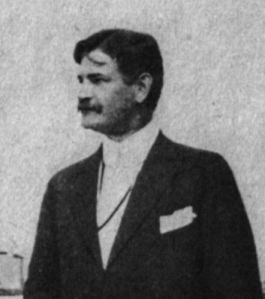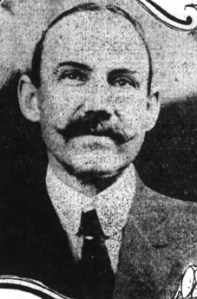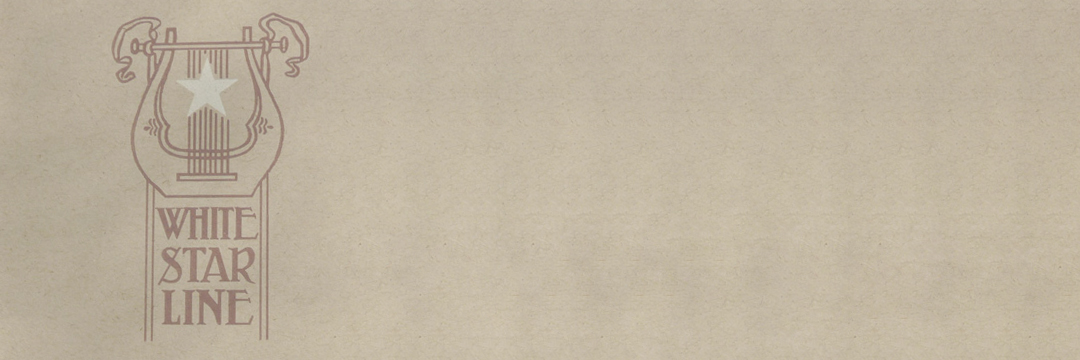The tale of Titanic’s last performance usually goes something like this:
“…as the eight assembled to perform together for the first time, they risked everything for the sake of others. They played in a lounge and then at the top of the 1st Class Grand Staircase while passengers put on their lifebelts and awaited orders to enter lifeboats… Later they followed the passengers out onto the deck, and continued to play.”
That is a quote from the current edition of my own book, TITANIC A Voyage in Piano Music, from the page of historical notes. It would seem, then, like a contradiction for my blog to be one of the first proponents of the idea that Titanic’s two ensembles played separately throughout the night, and that each one remained in only one location, never coming together to play.
When I first published my piano books I looked completely to the information available, based mostly on press reports, about Titanic’s bands. Even at the beginning of Titanic Piano, in a post called “Was Titanic’s last performance impacted by separate libraries?” I was still unwilling to let go of the doctrine that Titanic’s bands had performed together in the last hours. However, press reports have proven to be unreliable in the details, and such seems to be the case once again with the matter of the band’s final performance.
Two books changed my thinking: first, TITANIC The Ship Magnificent, with detailed plans of the ship, and second, On Board RMS Titanic, with numerous first-hand survivor accounts. The cross reference between these books made it possible to gather a number of survivor accounts and analyze them for the timing and location of Titanic’s final performances. Interpreting location is perhaps the biggest indicator in figuring out whether the bands came together to perform as one.
During the voyage Titanic’s trio performed in the Reception Room outside the à la carte Restaurant and Cafe Parisien. On Sunday night, April 14, before the collision, Hugh Woolner was one of the last to leave the jolly scene at the Restaurant as patrons drifted off to their cabins. In a letter to his family written on board Carpathia, Woolner recounted how he and his friends had sauntered up the aft Grand Staircase from the Reception Room on B Deck to the Smoke Room just above on A Deck. Although he did not mention the band, it was Woolner’s account that caused me to notice how close the First Class Smoke Room was to the band’s regular performance venue.
The significance of the proximity of the Reception Room and the Smoke Room is realized in an account by Archibald Gracie which describes his experience after the iceberg had been struck.
Archibald Gracie, The Outlook, April 27, 1912:
“Now followed the firing of sky-rockets and the assembling of the passengers together to be loaded on the boats on the boat deck. … About this time I went into the smoking room, and, as usual, I saw there seated around the table four good friends… It was at this time that I also heard the band play with the evident purpose of instilling courage and stopping confusion.”

The fact that Gracie mentioned hearing music while he was in the Smoke Room indicates that it was the trio’s music, carrying up one level of the stairs. This account by Gracie was the first evidence I had seen that suggested the trio performed in their regular venue during the sinking. This, in turn, suggested that the bands played separately, as there was already ample evidence to support the quintet’s prolonged performance on the Boat Deck level of the forward Grand Staircase.
It has been said that the band began to play at 12:15am, with the belief that all eight bandsmen had assembled and begun to play in the same place at the same time. But evidence now suggests that it was the trio that began to play at this early time, as passengers first gathered together.
Archibald Gracie, The Truth About the Titanic, 1913:
“…Mr. and Mrs. Strauss, Colonel and Mrs. Astor and others well known to me were among those here congregated on the port side of Deck A…. It was now that the band began to play, and continued while the boats were being lowered. We considered this a wise provision tending to allay excitement. I did not recognize any of the tunes, but I know they were cheerful and were not hymns.”
Two stewardesses noticed men tapping their toes to music on A Deck, the topmost level in this aft area of the ship. The fact that these two ladies eventually went off in lifeboat 11 suggests their experience centred near the performance of the trio, which played one level down on B Deck. It was the open design of the after grand staircase that allowed strains of music to carry up one level.
Kate Gold, Annie Martin, stewardesses, Western Daily Mercury, April 30, 1912:
“On deck… the bandsmen were playing “rag-time” music as the crew were getting out the boats, and it was a noteworthy fact that so interested and engrossed in their duty were these gallant musicians, that they would not stop playing to put on the life-belts which were brought to them.”
Annie Martin, stewardess, Liverpool Daily Post, 1912:
“They were playing. When we left the side of the ship [in lifeboat 11 at 1:25] the men were sitting on the companionway on the A Deck forward with lifebelts by their sides. They were making no attempt to put the belts on. Many of them were smoking. Others were beating time to the music with their feet.”
Kate Gold, stewardess, 1912:
“When we left the ship men were sitting on A deck, smoking cigarettes and tapping time with their feet to the music of the band. These passengers and the bandsmen, too, had their lifebelts beside them, and I was specially struck by a glimpse of a violinist playing steadily with a great lifebelt in front of him. The music was ragtime just then.”
It is important not to get thrown off by certain details in these accounts, for the stewardess’s accounts were interpreted and written by reporters, and may have been inadvertently changed by them. Notice that “on deck” paints an image of the bandsmen playing outside. It is possible that a stewardess said the bandsmen played on deck (a common way to refer to any level of the ship inside or out) and that the reporter assumed this meant the outer deck. The version that specified that “…the men were sitting on the companionway on the A Deck…” places them inside the ship.
Although one version says “A Deck forward,” and seems to point directly to a performance location at the front of the ship, everything else that is known about Gold’s and Martin’s experience points aft: the presence of smoking men places them near the First Class Smoke Room on A Deck, as well as their places in lifeboat 11, which was lowered from the Second Class area of the starboard deck, aft.
Another clue as to whether the musicians performed separately is mention of the number of men in the band. In the following account Washington Dodge, who had seen the five-piece band perform earlier on Sunday evening in the First Class Reception Room, noted that he saw the same band performing after the collision.
Washington Dodge, The Loss of the Titanic, 1912:
“Following the collision the band which had earlier in the evening given the usual Sunday evening concert, continued to play. They played ragtime and other lively music. But a few moments before the steamer sank, when the danger was apparent to all, they were playing “Lead Kindly Light.” There were five musicians, all of whom were lost.”

Dodge’s account is interesting because he pinpointed the number in the band, which suggests the quintet performed on its own. It seems by his words that he did see the band’s performance at some point, because he was able to say it was the same five-piece band that had performed earlier. However, he went off in boat 13 at 1:25, so he wouldn’t have seen or heard the quintet’s performance at the last, nor would he have heard the music clearly enough from the lifeboat to identify the hymn he mentioned.
It does seem as though there is evidence that the bands never performed together as Titanic sank. If so, they would have reached more passengers through two performances. The calming effect of their music would have covered more area on the ship.
The idea that the bands came together to play in Titanic’s final hours had originated with Charles Black, of C. W. & F. N. Black, employer of Titanic’s band; originated with a man who had not set foot on Titanic nor witnessed the event. Yet this idea gained traction with the press and public and became part of the legend of the sinking of the great liner. A close inspection of survivor accounts and a knowledge of the ship’s design suggests otherwise: that the quintet and trio performed as separate ensembles.
In the next post: Did any Titanic survivors hear both bands during the sinking? What time did the band stop playing?
Related Posts
- Did Titanic’s bands play together as Titanic sank?
- Titanic’s second band: Trio for Restaurant and Cafe Parisien
- When did Titanic’s bands stop playing?
Links

On Board RMS Titanic , George M. Behe

TITANIC The Ship Magnificent, Beveridge, Klistorner, Hall, Andrews.



Some time ago I was saying about \”Passing of Salome\”, and the problem whether the waltz was composed in 1912 or earlier, but I didn't notice that wikipedia says that an other waltzes by Joyce, \”A Thousand Kisses\” – was composed in 1913 (!)and Remembrance in 1914 (!). Wikipedia is poor source (I don't have any other about Joyce) so it can be wrong, but if it's true, then we can throw this songlist to the garbage.
LikeLike
Yes, if the dates on Wiki are right, this songbook would have been published after Titanic sailed. There is one printed in the last pages of a book by Yvonne Hume called Titanic's First Violin, which is similar and may be the more accurate book.
LikeLike
Is it complete songbook printed, or only some part? And maybe do you know how many numbers it has? Two songbook are around, the one we has, with 341 number, and an other, with 352 numbers…
LikeLike
Yes, there is a complete 9-page songbook with cover printed, almost like an appendix to her book. In 100 years no historian has been able to pinpoint for sure the songbook that was used on Titanic. A that time it may have been updated several times each year, and accuracy depends on whether people saved any copies. Perhaps this could be your personal project! I'd love to hear your analyses on several versions of the songbook.
LikeLike
I am not sure if I understood your comment. Do you want me to compare some songbooks? Actually, I don't have the copy from the book by Yvonne Hume, so I can't do anything. I can't buy it too because of some reasons which has something to do with that I live in Poland. Also, some time ago, I met on the net a person who has some copies of songbooks from White Star Line and Cunard. He told me, that he would be kind and able to scan it to me, so I can ask him to send me these…
LikeLike
Yes, I think it would be great for you to study and compare songbooks. I might too someday, but I have so many irons in the fire that I might not get to this one right away. Too many other things to finish first.
LikeLike
Great information that you've posted here! I enjoy studying about the Titanic myself. I did notice that most people portray all 8 musicians playing together… but how were we ever sure of that fact? You've done a great job outlining all the survivor accounts on the subject.This is my first time on your blog. I'm going to have to read through any of your other Titanic posts! (Very exciting for me!)
LikeLike
Tarissa, Thanks for stopping by! My blog is divided into several larger subjects, and the posts are roughly organized by topic. January – focus on the songbook, leading up to…Feb/March – focus on the final number performed on the night of the sinkingMarch/April – pianos and performance locations by classMay – where bands played during sinkingJune/July – instrument lists, who played in which bandHope you enjoy! Feel free to comment! – Rebekah
LikeLike